Young NB soldier killed in the final hours of WW1 finally gets his due

For the first Remembrance Day since he was killed in action exactly 102 years ago, Pte. Xavier Boudreau's headstone in Dour, Belgium will properly reflect his heroic service in the First World War.
Boudreau, who was from Dalhousie, was awarded the Military Medal for "gallantry and devotion to duty under fire" for carrying a wounded superior — and others — to safety during the final 100 days of the war.
But after being killed in action on Nov. 8, 1918 — mere hours before an armistice would silence the guns of battle — Boudreau was laid to rest at a Belgian cemetery.
While a fellow soldier's headstone proudly displayed the "MM" engraving that signified his war medal, Boudreau's did not.
It would remain that way for more than 100 years.
It wasn't until a determined amateur historian stumbled across Boudreau's story that the omission was discovered and eventually corrected — much to the delight and gratitude of the young soldier's family.
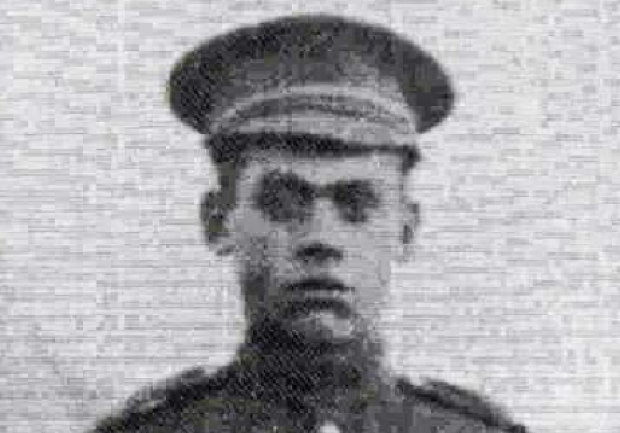
Richard Stevens, who grew up in Saint John, belongs to a World War I history society in Halifax.
While trying to come up with a topic to present to the group, he remembered a trip to Belgium in 2019, when he visited the grave of a Nova Scotia man believed to be the last allied soldier killed in the First World War.
Pte. George Price died at Mons, Belgium, about two minutes before the signing of the armistice at 11 a.m. on Nov. 11, 1918.
That got him wondering about who the last New Brunswicker was to die.
His research revealed that it was either Boudreau or Sgt. Howe Leroy Stevens, who was from Saint John. Both were killed at about the same time on Nov. 8, less than 50 hours before the war ended.
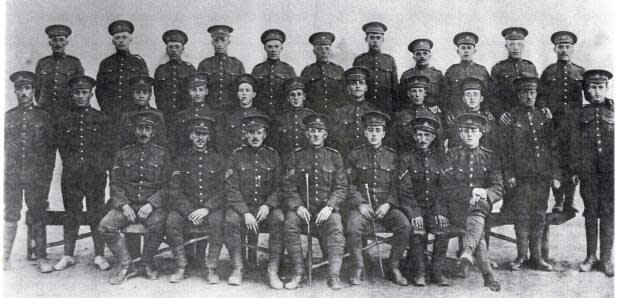
The two are buried side-by-side in a cemetery in Dour.
Stevens said he was struck by the "spectacular way in which Xavier won his military medal."
It was for his actions on Aug. 8, 1918 — the first day of a series of battles that would ultimately lead to the end of the war, said Stevens.
Boudreau's battalion was advancing into German-held territory and was caught in crossfire from enemy forces in front and on their flank.
A lieutenant from Charlottetown was mowed down, said Stevens, "and young Xavier saw this and selflessly jumped from cover and ran amid a hail of bullets to where Lt. Paton was."
He picked up the officer and carried him to safety.

The citation for his medal reads, "Under heavy rifle and machine gun fire carried a badly wounded Lieut. Paton to a place of safety, and on two other occasions exposed himself to danger while carrying wounded men to cover."
Stevens said it became very important to him that Boudreau be properly recognized for his actions.
"I think that this young man gave everything he had for this country and for a fight for freedom. And he had earned this medal in such a spectacular fashion," said Stevens.
WATCH | New Brunswick soldier's bravery overlooked for more than 100 years
"He lays in a little graveyard in Dour, just outside of Mons and his sergeant, Howe Leroy Stevens, had his Military Medal inscribed on his gravestone but Xavier Boudreau did not.
"That just struck me as unfair — that this man's gallantry should be omitted from his grave marker."
So he set out to make things right.
But it turned into more of a battle than he anticipated.
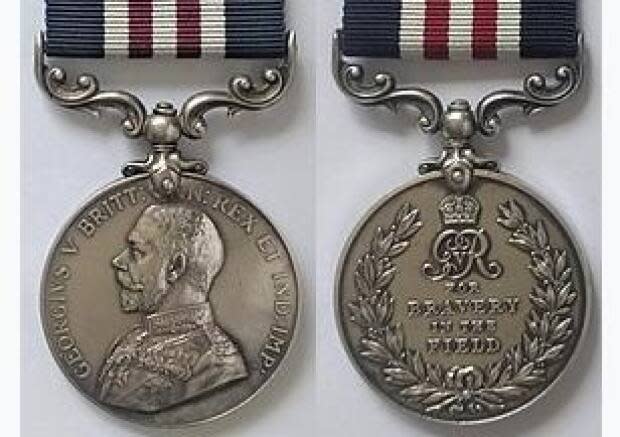
He contacted the Commonwealth Graves Commission in the United Kingdom and was initially assured that they would add the "MM" engraving the next time the stone was replaced.
"I don't know how often gravestones are replaced but I'm guessing they may last a long, long time.
"And I didn't think that he or his family should have to wait any longer," said Stevens.
He didn't have much luck swaying the commission until Boudreau's family got involved.
Patricia Seman lives in Lansing, Michigan now, but she grew up in Dalhousie. She was aware that her great uncle had been killed in World War I, but she had no idea of the circumstances.
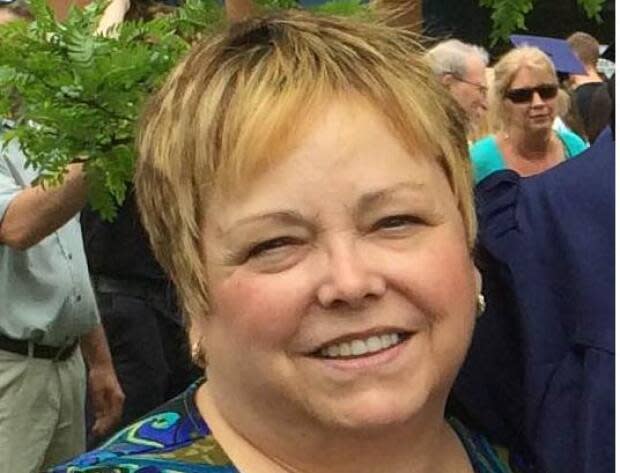
Stevens was able to fill in the missing details of his war service — and his bravery in battle.
And Seman was able to add a few more interesting details to Stevens' research — like how Boudreau lied about his age when he enlisted. His attestation papers were signed on Jan. 20, 1916 and he listed his birthdate as Feb. 20, 1898.
Seman said his birthday was actually Nov. 26, 1898. He had just barely turned 17 when he signed up.
Seman is moved by the eagerness of someone so young to sign up to fight for the freedoms we all enjoy today. And as a mother, she cannot imagine having to send off a son at such a tender age.
She's also grateful that a complete stranger would work so hard to have her great uncle's accomplishments duly noted on his headstone.
"That was a big deal to me," she said.
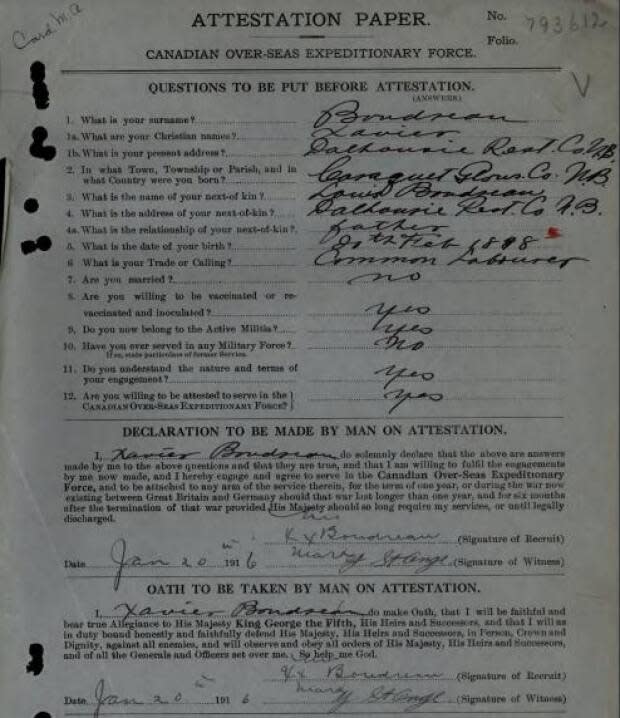
"When he got that medal, to me it was like the cherry on the sundae. It was just like, 'Yes, you got what you deserve. This is it. You're recognized.'
"It was a very nice feeling to see that new stone. And I hope one day, I get to go there and see it in person."
Boudreau was laid to rest in a cemetery along with three other Canadians and 10 British soldiers. A photo shows the row of narrow headstones, darkened by age and the elements.
But when the commission installed a brand-new stone for Boudreau, it also cleaned up the other stones.
"This brave young man from Dalhousie, New Brunswick now has the full final recognition he so richly deserves," said Stevens.
The full meaning of being one of the final casualties of war is not lost on Stevens, who has managed, with the help of some contacts in Europe, to piece together the final moments of the two New Brunswickers who were killed in the dying hours of the war.
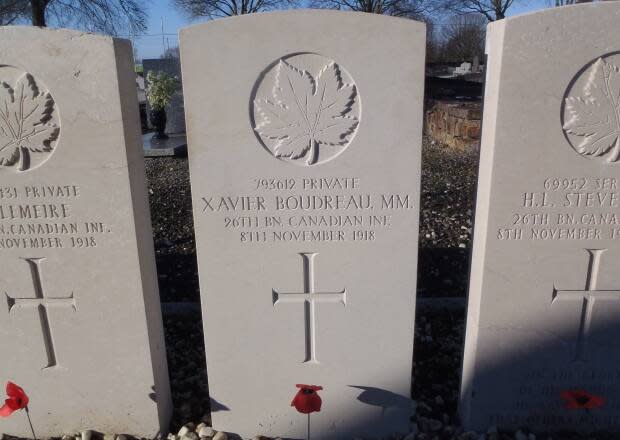
Stevens said the 26th Battalion was still on the offensive on Nov. 8, 1918.
"They gained some 12 km in territory. It was a tremendously successful engagement."
It was getting close to midnight, said Stevens, and since they were so close to their objective, the battalion commander ordered them to continue the attack.
"And so sadly, they obeyed the order ... and charged forward and both men were cut down by machine gun fire," recounted Stevens.
He said Boudreau was shot in the throat and very likely died almost instantly.
"Ironically, the next morning, a new battalion came in to take over the line and the Germans had abandoned that ground. They had retreated," said Stevens.
"So, had Xavier Boudreau been told just to sit tight, wait until the morning, they could have walked to the railway embankment and the Germans would have been long gone."
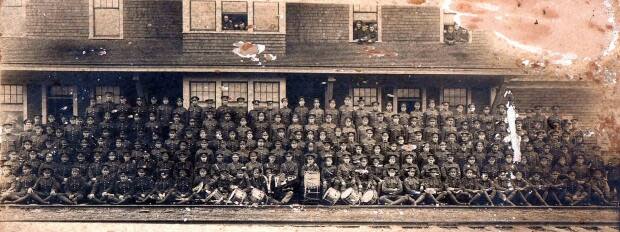
Stevens is viewing Remembrance Day 2020 with mixed emotions.
While content that Boudreau's headstone finally bears the recognition he is due, Stevens won't be marking it the same way he has in past years since most public commemorations have been cancelled because of the pandemic.
"So this year, I'm going to take a more solitary approach," he said.
On Wednesday, he'll visit Camp Hill Cemetery in Halifax with a bucket of soapy water to clean off the moss-covered headstone of a young machine gunner killed during the Battle of Passchendaele.
"I'll place a poppy on his grave and just take a moment to remember.
"And that'll be my Remembrance Day this year."


